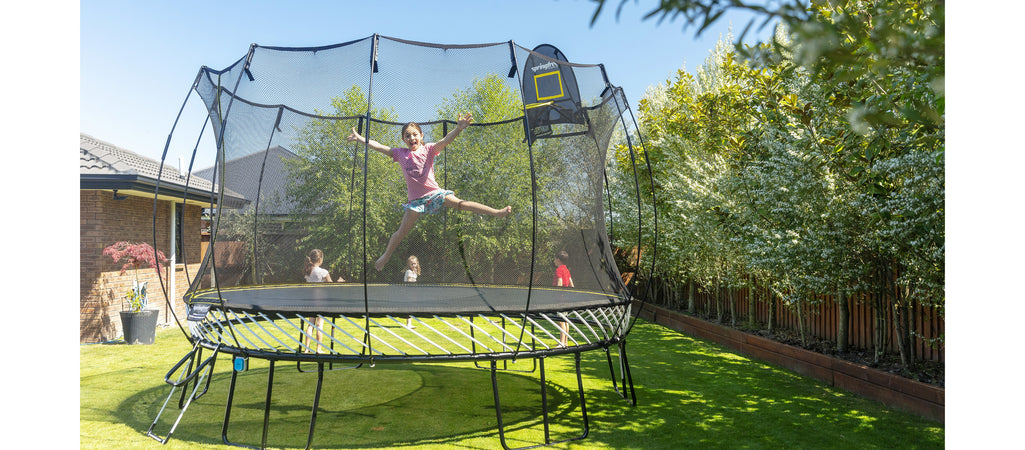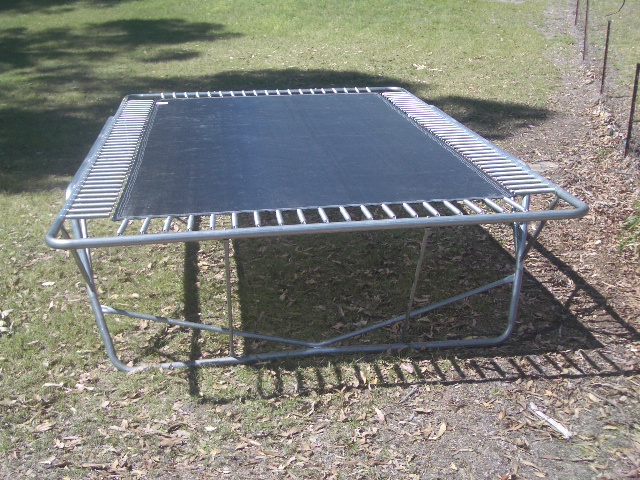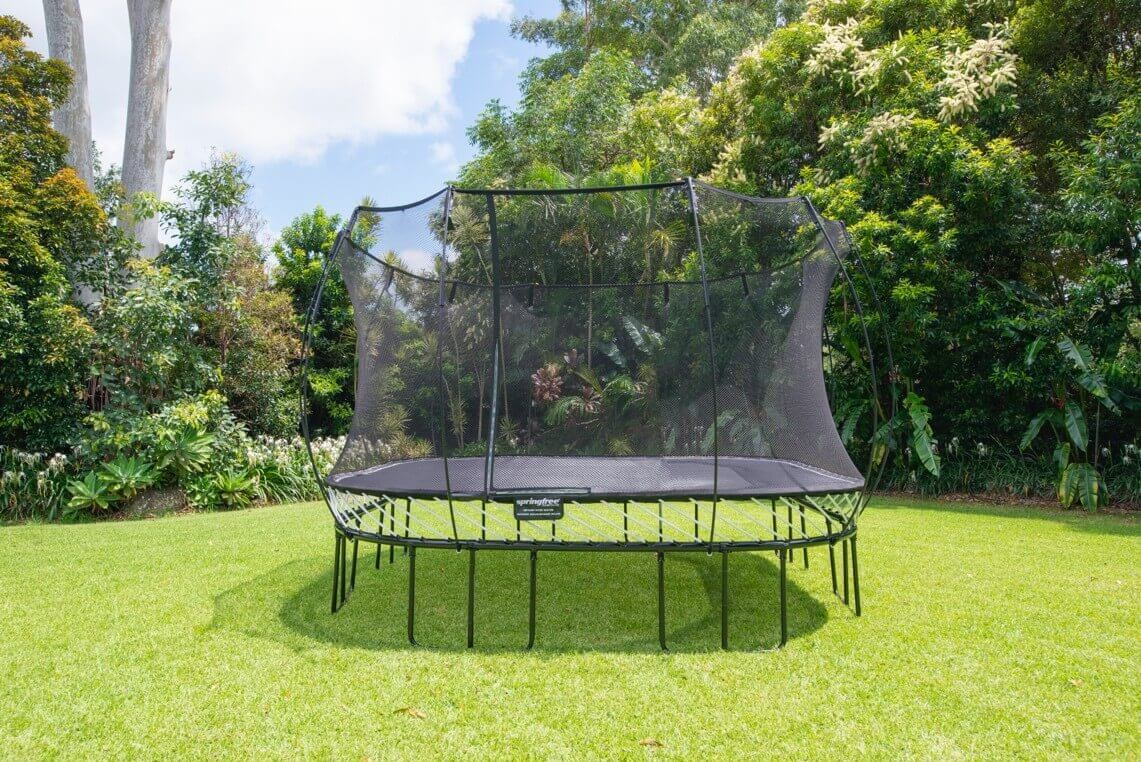Are Trampolines Safe? | What You Need to Know
Discover the answer to the long-debated question, "Are trampolines safe?", find out what influences a trampoline's safety and learn if one is right for you!
min read

The safety of trampolines has been debated ever since their introduction to the marketplace in the mid-20th century.
Some parents are firm against trampolines due to the risk of injury. Others think it is the perfect way for kids to get outside and active.
So, what’s the truth? Are trampolines safe or are they dangerous?
As the inventor of springless trampolines—where safety was the chief consideration behind the invention—the safety of trampolines is the essence of our existence. We created the world’s safest trampoline and spend seemingly every working day answering questions related to the safety of trampolines.
With the decades of experience we’ve gained as a trampoline innovator and manufacturer, we are here to be your guiding light to honestly and objectively answer the questions you have regarding the safety of trampolines.
We’ll detail the risks and benefits of trampolines, so you get a feel for both sides of the argument.
After that, we will provide you with tips for staying safe on a trampoline, before finally answering the question, once and for all, “Are trampolines safe?”
The Dangers of Trampolines
We’re not breaking news by saying that the main concern about buying a trampoline for many parents is the risk of injury for their children.
There’s no hiding behind the fact that trampolines can be dangerous. In 2018, over 300,000 people suffered a trampoline injury in the U.S., according to the American Academy of Orthopedic Surgeons (AAOS), with 110,000 of those having to go to the emergency room.
The total number has only gone up, as there was a 16.1% increase in trampoline injuries from 2019-2020. This was likely due to the heightened demand for backyard trampolines as the COVID-19 pandemic forced people to stay at home, where they were more inclined to buy a trampoline rather than go on vacation.
These stats show that trampolines, especially cheaper ones made from inexpensive materials, can still cause injuries at a high rate. And they usually happen to children between the ages of 5 and 14, where more than 90 percent of trampoline injuries occur, according to AAOS.
There are multiple causes for injuries on a trampoline, but some of the most common are:
-
Multiple people colliding while jumping on the trampoline at the same time.
-
Falling on the trampoline mat, frame or springs without adequate padding.
-
Performing flips or other tricks and landing awkwardly.
-
Falling off or through the trampoline and to the ground.
The Benefits of Trampolines
Just as there are risks to trampolines, there are also plenty of benefits to trampolines.
The health benefits of trampolines, both mental and physical, can be immense for both kids and adults.
On the physical side, jumping on a trampoline can increase your heart health and cardiovascular system, protect your joint health, develop your balance skills and help with weight loss, among other things.
This is corroborated by various studies, including one by the American Council of Exercise that showed that trampoline jumping is more efficient than running on a treadmill for the same amount of time.
It can also be a boon for your mental health, as the fun of trampoline jumping can release endorphins—chemical signals in the brains associated with happiness—which can decrease stress levels.
For children, jumping on the trampoline can be a fun way to burn energy outside and away from screens. In a world dominated by smartphones, trampolines are still a popular choice for parents to get their kids outside and away from technology.
5 Tips to Stay Safe on a Trampoline
Before we give the final answer to the “Are trampolines safe?’ question, there is more information you need to know before getting to that point.
So much of the answer to the trampoline safety question depends on things that are in your control, such as the type of trampoline you buy, where you place it, the rules you establish and the amount of supervision you provide for your kids.
We’re going to go over all of these in more detail as “tips” to stay safe when jumping on a trampoline:
-
Buy the Right Trampoline
If you want to stay safe on a trampoline, the first thing and most crucial thing you need to consider is the trampoline you’re jumping on.
If your trampoline looks like this, then the chance of injury is going to be very high (photo courtesy of Topline Trampolines):

Most modern-day trampolines do not look like the one above. Manufacturers nowadays follow trampoline standards, like the American Society for Testing and Materials, that lay out safety precautions all trampolines are recommended to include. One of these, for example, is that trampolines should all have enclosure nets.
There are two main types of trampolines you can choose from: Spring or springless. Let’s go over them in more detail:
Spring vs. Springless Trampolines
Spring-based trampolines used to be the only type of outdoor trampoline you could buy—and they are still the most common type of trampoline today.
But our company (Springfree Trampoline) started selling the springless design in the mid-2000s and they have now become a popular alternative to the spring trampoline.
Springless trampolines are much safer compared to spring-based trampolines. At the base level, replacing springs with composite rods or bungee cords eliminates the chance of pinching injuries that come from springs.
But they also come equipped with other features that protect against injury. For example, our Springfree Trampolines include safety features like a hidden frame, a FlexiNet, which is held by flexible enclosure rods, and the SoftEdge mat that covers the area where the rods meet the mat and is 30x more cushioned than traditional safety pads.
Because they are safer, though, springless trampolines tend to be more expensive. Read through our article on the differences between spring and springless trampolines to learn more.
See the image below to see what a springless trampoline looks like:

In addition to the springs or springless decision, you also need to decide how you want to install the trampoline, either above the ground or in the ground.
Inground vs. Above Ground Trampolines
Inground trampolines, in general, tend to be safer than above ground trampolines because they eliminate falling injuries since they’re installed into the ground. See the picture below to see an inground trampoline (via Trampolines Inground):

However, inground trampolines still come with safety risks—such as falling on the metal springs, frame or surrounding area—and the cost of installing a trampoline in the ground is not practical for most families. It can cost up to $5,000 or more to install a trampoline in the ground and it is a permanent backyard commitment for most.
Read our article dissecting the differences between inground and above ground trampolines to learn more!
-
Find the Right-Sized Trampoline
The next tip needed to make sure your jumpers are safe is to find the right-sized trampoline.
Most importantly, you need to make sure you get a trampoline than can accommodate the jumper’s weight.
Almost every manufacturer will list a “single jumper weight capacity” or “single user weight” that specifies the maximum weight you can jump without bottoming out or falling through the trampoline.
For example, our smaller Springfree Trampolines have a recommended single jumper weight capacity of 175 pounds, while our bigger models have a weight capacity of 220 pounds.
While they can technically all hold 1,500 pounds at a static weight, the single jumper weight capacity takes into account the weight of the jumper when they reach maximum height on the trampoline.
If you or a jumper weighs more than the recommended weight capacity, then you should look at another trampoline that can safely hold your weight. While you can still jump on a trampoline if you weigh more than the listed weight capacity, you do run the risk of bottoming out.
-
Find a Safe Area to Place the Trampoline
To make sure your trampoline is as safe as possible, you need to find a place in your yard that is spacious and can accommodate the size of the trampoline.
We recommend that you find an area that is clear of branches, debris, fences and slopes. Here are some further recommendations for finding a spot:
-
Find a spot that is flat and even (if the space you have isn’t level, we recommend the rise/gradient be no more than three degrees across the whole space. We don’t advise installing a trampoline where the slope is greater than that).
-
Safe lateral clearance space of 3-5 ft on all sides of the trampoline.
Check out our article, “What Size Trampoline Do You Need” to read more on how to find the right, and safe, spot for your trampoline.
4. Pay Attention to the Safety/Quality Features
We touched on safety/quality a bit in the “Springs vs. Springless” section, but trampolines differ in how they are constructed, and some are built safer and stronger than others.
When shopping for a trampoline, you typically want to see, at a minimum, these safety/quality features:
-
An enclosure net that flexes and is made from strong material.
-
No springs or quality safety padding over the springs (you also want to see the springs outside of the mat area).
-
The use of enclosure rods or non-static poles.
-
A shock-absorbent mat.
-
A frame that is covered or hidden.
-
The use of weather-resistant, rust-resistant and/or UV-protected materials.
For more on these features, and others, check out our seven things to look for when buying a trampoline!
-
Establish Ground Rules
The final tip to staying safe on a trampoline is to establish ground rules, especially for kids ages 6-14. Unless you’re buying a toddler trampoline, children under six years old SHOULD NOT jump on an outdoor trampoline.
Some common ground rules that we recommend include:
Rule #1: One Jumper at a Time – Make a rule that only one person can jump on the trampoline.
Rule #2: No Flips or Tricks – Make a rule banning your kids from flipping or attempting air tricks on the trampoline.
Rule #3: Supervise at All Times -- If your child is under 12 years old, adult supervision is recommended.
Some states have laws, or at the very least recommendations, on how to use a trampoline (see TX Section 748.3893 for an example). Setting and strictly enforcing rules for trampoline use is one of the fundamental ways to avoid trampoline injuries and is something you can absolutely control.
The Verdict: Are Trampolines Safe?
So, now comes the answer to the ultimate question: Are trampolines safe?
Just like most things, the answer is…It depends.
There is an inherent risk to jumping on a trampoline. Studies and statistics on trampoline injuries bear this out.
But if you purchase a trampoline that comes with sufficient safety features, can handle your weight, place it in a spacious area and establish ground rules for jumping, then trampolines are generally safe and can be enjoyed by almost everybody.
However, buying a trampoline requires accurate research and self-evaluation. Forgoing the research process and buying the wrong trampoline could lead to a trip to the emergency room.
Summary Statement: Trampolines do come with a risk for injury. But if you take the time to purchase the right one for your family, the injury risk is mitigated, and the benefits likely outweigh the dangers of a trampoline.
What Is the Best Trampoline for You?
If you’ve assessed the safety of trampolines and decided that you want to look into buying one for your family, the next step is to get the right one for you.
We know from experience that this part of the research process is the most important to ensuring the safety of all your jumpers.
Thanks to our decades of experience and exhaustive study of the trampoline industry, we’ve created lists of the best trampolines you can purchase this year!
If you want to see the top trampolines on the market at various price points as you look to decide on which trampoline to purchase, then these lists will be a helpful resource for you.
We’ve broken them down by size, so if you don’t want to read through them all, choose the size you think is most fitting for you:
And if you’re stuck on the safety question and need some honest and professional advice, we have a team of Springfree experts that can help answer any questions you may have.
Reach out to us and one of our team members will assist you shortly!


